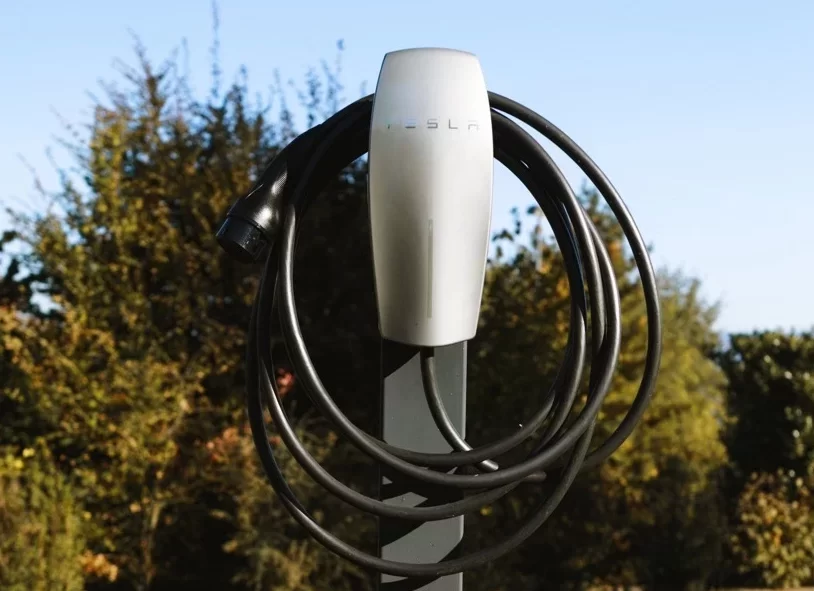In Australia, both Tesla and non-Tesla owners widely utilize the Tesla Destination Charger, making it a popular choice for electric vehicle charging. These chargers, considered Level 2 chargers, can supply up to 22kW of power, depending on the charger’s power output configuration. As of February 2024, there are 668 Tesla Destination Charging locations across Australia and over 40,000 worldwide. This comprehensive blog post explores its functionality, eligibility to Non-Tesla cars, charging costs, distinctions from superchargers and available locations.
⏭ Jump Ahead
- About Telsa Destination Charger.
- Can Non-Tesla Use Destination Chargers?
- How Much Does it Cost to Charge?
- Distinction from Superchargers.
- Available Locations.
About Tesla Destination Charger
As highlighted in the introduction, Tesla Destination chargers fall under the category of Level 2 AC chargers. These chargers are designed for AC charging and have a maximum power output of 22kW, although this output may vary depending on the location. Typically found in shopping centres, airports, malls, venues, workplaces, Airbnbs, hotels, motels, and public spaces, they’ve earned the name “destination charger” for their convenience.
Australian Tesla Destination Chargers come with either a Type 2 charging plug (standard in Australia) or a Tesla charging plug type (NACS plug). While plug types may differ between locations, the majority of new destination chargers installed since 2018 feature Type 2 plugs. Additionally, cable lengths typically range from 5 meters to 7.5 meters. Charging sessions, payments(if not made free) and other information can be managed via the Tesla mobile app.
Can Non-Tesla Use Tesla Destination Chargers?
Yes, non-Tesla vehicles can utilize Tesla destination chargers under certain conditions. Firstly, the destination charger must be designated for use by non-Tesla vehicles at that particular location. Some locations may have explicit signage indicating “Tesla Vehicles Only,” which would restrict access for non-Tesla EVs.
Assuming the first condition is met, compatibility of the destination charger plug type becomes crucial. If the charger uses the NACS Tesla plug type, non-Tesla vehicles equipped with Type 2 or Type 1 ports will require corresponding adapters to initiate charging. Conversely, if the destination charger features a Type 2 plug, non-Tesla vehicles can typically charge without the need for an adapter.
As of February 2024, the majority of destination chargers are accessible to non-Tesla vehicles, enhancing convenience for all EV owners. This inclusivity reflects a broader trend towards interoperability and accessibility within the electric vehicle charging infrastructure.
How Much Does it Cost to Charge?
Tesla destination charging is predominantly offered as Free for both Tesla and non-Tesla vehicles. However, certain locations may require payment, with costs varying depending on location and ownership status. Pricing is typically tied to electricity rates across states and territories in Australia. Ownership also influences pricing, with Tesla owners generally enjoying lower rates compared to non-Tesla owners. On average, charging at Tesla destination charging stations costs around 0.30 cents per kWh. To calculate your custom charging cost explore our EV charging cost calculator.
To determine if charging is free at a location, simply attempt to plug in the charger to your vehicle. If charging begins automatically, it’s free. If not, you may need to use the Tesla app. Set up your account on the app (if you don’t have an account) and follow the instructions to initiate charging. Pricing information is conveniently displayed in the Tesla mobile app, which is available for download on both the iOS App Store and Android Google Play Store for Tesla and non-Tesla users alike.
Difference between Destination Chargers from Superchargers
Tesla’s Destination Chargers and Superchargers serve distinct purposes and exhibit notable differences:
Power Source
– Destination Chargers: AC powered for extended parking periods.
– Superchargers: DC-powered for rapid charging on highways.
Charging Speed
– Destination Chargers: Max 22kW AC output, slower charge.
– Superchargers: V3 models offer up to 250kW DC, rapid charge.
Charging Time
– Destination Chargers: Longer time to fully charge EVs.
– Superchargers: Faster charging, ideal for quick pit stops.
Installation Complexity:
– Destination Chargers: Typically simpler installation.
– Superchargers: More planning and resources are required.
Cost and Sustainability:
– Destination Chargers: Often free, aligned with sustainability.
– Superchargers: Usage may incur fees, focus on rapid charging.
Know about Tesla Supercharger’s availability to non-tesla here.
Available Australia Locations
There are more than 668 Tesla Destination charging locations in Australia, below is the list as per the data from the Tesla Australia website.
Map credit: plugshare
Summary
In Australia, Tesla Destination Chargers serve as integral components of the electric vehicle charging infrastructure, offering Level 2 AC charging with a maximum output of 22kW. Strategically located in public spaces like shopping centres, restaurants and hotels, they cater to the changing needs of both Tesla and non-Tesla vehicles, promoting inclusivity and accessibility within the EV community. While primarily designed for Tesla vehicles, non-Tesla EVs can utilize these chargers provided they adhere to usage conditions and ensure compatibility with charger plug types. Charging costs vary, with many locations offering complimentary services, though some may require payment influenced by factors like location, ownership status, and electricity rates. Tesla’s mobile app facilitates charging session management, pricing access, and payment initiation, streamlining the charging experience.

